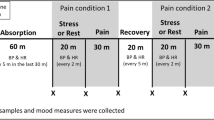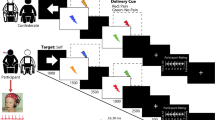Abstract
We investigated the hypothesis that the effects of Monitoring and Blunting coping styles are mediated in part by endogenous opioids. Mean arterial pressure (MAP) and heart rate (HR) were measured in 39 males before, during, and after a mental arithmetic stressor. Each subject experienced the protocol once under opioid blockade (naltrexone) and once in a placebo condition, in counterbalanced order. Monitoring and Blunting were assessed using the Miller Behavioral Style Scale. High Blunting and high Monitoring were both associated with poorer MAP recovery under opioid blockade than in the placebo condition. Similar effects were noted for Blunting on the measure of HR. These results indicate that the coping styles of Monitoring and Blunting may be associated with enhanced opioid mediation of cardiovascular recovery from stress.
Similar content being viewed by others
References
Bandura, A., O Leary, A., Taylor, C. B., Gauthier, J., and Gossard, D. (1987). Perceived self-efficacy and pain control: Opioid and nonopioid mechanism.J. Pers. Soc. Psychol. 53: 563–571.
Bruehl, S., Carlson, C. R., and McCubbin, J. A. (1992). The relationship between pain sensitivity and blood pressure in normotensive.Pain 48: 463–467.
Cohen, J., and Cohen, P. (1983).Applied Multiple Regression/Correlation Analysis for the Behavioral Sciences, Lawrence Erlbaum Associates, Hillsdale, NJ.
Cohen, F., and Lazarus, R. S. (1973). Active coping processes, coping dispositions and recovery from surgery.Psychosom. Med. 35: 375–389.
Cohen, S., and Williamson, G. M. (1991). Stress and infectious disease in humans.Psychol. Bull. 109: 5–24.
Efran, J. S., Chorney, R. L., Ascher, L. M., and Lukens, M. D. (1989). Coping styles, paradox, and the cold pressor task.J. Behav. Med. 12: 91–102.
Haynes, S. N., Gannon, L. R., Orimoto, L., O'Brien, W. H., and Brandt, M. (1991). Psychophysiological assessment of poststress recovery.Psychol. Assess. 3: 356–365.
Hofer, M. A. (1982). Some thoughts on the transduction of experience from a developmental perspective.Psychosom. Med. 44: 19–28.
Jamner, L. D., and Schwartz, G. E. (1986). Self-deception predicts self-report and endurance of pain.Psychosom. Med. 48: 211–223.
Light, K. C., and Obrist, P. A. (1980). Cardiovascular responses to stress: Effects of opportunity to avoid, shock experience, and performance feedback.Psychophysiology 17: 243–252.
Manuck, S. B., Harvey, S. H., Lechleiter, S. L., and Neal, R. S. (1978). Effects of coping on blood pressure responses to threat of aversive stimulation.Psychophysiology 15: 544–549.
McCubbin, J. A. (1991). Diminished opioid inhibition of blood pressure and pituitary function in hypertension development. In McCubbin, J. A., Kaufmann, P. G., and Nemeroff, C. B. (eds.),Stress, Neuropeptides, and Systemic Disease, Academic Press, San Diego, pp. 445–466.
McCubbin, J. A. (1993). Stress and endogenous opioids: Behavioral and circulatory interactions.Biol. Psychol. 35: 91–122.
McCubbin, J. A., Surwit, R. S., and Williams, R. B. (1985). Endogenous opiates, stress, and risk for hypertension.Hypertension 7: 808–811.
McCubbin, J. A., Surwit, R. S., and Williams, R. B. (1988). Opioid dysfunction and risk for hypertension: Naloxone and blood pressure responses during different types of stress.Psychosom. Med. 50: 8–14.
McCubbin, J. A., Surwit, R. S., Williams, R. B., Nemeroff, C. B., and McNeilly, M. (1989). Altered pituitary hormone response to naloxone in hypertension development.Hypertension 14: 636–644.
McCubbin, J. A., Wilson, J. F., Bruehl, S., Brady, M., Clark, K., and Kort, E. (1991). Gender effects on blood pressures obtained during an on-campus screening.Psychosom. Med. 53: 90–100.
McCubbin, J. A., Cheung, R., Montgomery, T. B., Bulbulian, R., and Wilson, J. F. (1992). Aerobic fitness and opioidergic inhibition of cardiovascular stress reactivity.Psychophysiology 29: 687–697.
Merluzzi, T. V., Taylor, C. B., Boltwood, M., and Gotestam, K. G. (1991). Opioid antagonist impedes exposure.J. Consult. Clin. Psychol. 59: 425–430.
Millan, M. J. (1986). Multiple opioid systems and pain.Pain 27: 303–347.
Miller, S. M. (1987). Monitoring and blunting: Validation of a questionnaire to assess two styles of information-seeking under threat.J. Pers. Soc. Psychol. 52: 345–353.
Miller, S. M., and Mangan, C. E. (1983). Interacting effects information and coping style in adapting to gynecologic stress: Should the doctor tell all?J. Pers. Soc. Psychol. 45: 223–236.
Miller, S. M., Brody, D. S., and Summerton, J. (1988). Styles of coping with threat: Implications for health.J. Pers. Soc. Psychol. 54: 142–148.
Miller, S. M., Leinbach, A., and Brody, D. S. (1989). Coping style in hypertensive patients: Nature and consequences.J. Consult. Clin. Psychol. 57: 333–337.
Morris, M., Salmon, P., Steinberg, H., Sykes, E. A., Bouloux, P., Newbould, E. McLoughlin, L., Besser, G. M., and Grossman, A. (1990). Endogenous opioids modulate the cardiovascular response to mental stress.Psychoneuroendocrinology 15: 185–192.
Phipps, S., and Zinn, A. B. (1986). Psychological response to amniocentesis. II. Effects of coping style.Am. J. Med. Genet. 25: 143–148.
SAS Institute Inc. (1985).SAS User's Guide: Statistics, Version 5, SAS Institute Inc., Cary, NC.
Steketee, G., Bransfield, S., Miller, S. M., and Foa, E. B. (1989). The effects of information and coping style on the reduction of phobic anxiety during exposure.J. Anx. Disord. 3: 69–85.
Suls, J., and Fletcher, B. (1985). The relative efficacy of avoidant and nonavoidant coping strategies: A meta-analysis.Health Psychol. 4: 249–288.
Taylor, S. E. (1990). Health Psychology: The science and the field.Am. Psychol. 45: 40–50.
Turner, J. R., Hewitt, J., Morgan, R., Sims, J., Carroll, D., and Kelly, K. (1986). Graded mental arithmetic as an active psychological challenge.Int. J. Psychophysiol. 3: 307–309.
Wilson, J. F. (1982). Recovery from surgery and scores on the Defense Mechanism Inventory.J. Pers. Assess. 46: 312–319.
Author information
Authors and Affiliations
Additional information
Preparation of the manuscript was supported by NIH Research Awards HL32738 and HL35195, NIMH training Grant MH15730, and General Clinical Research Centers Award M01 RR 2602 to the University of Kentucky.
Rights and permissions
About this article
Cite this article
Bruehl, S., McCubbin, J.A., Wilson, J.F. et al. Coping styles, opioid blockade, and cardiovascular response to stress. J Behav Med 17, 25–40 (1994). https://doi.org/10.1007/BF01856880
Accepted:
Issue Date:
DOI: https://doi.org/10.1007/BF01856880




